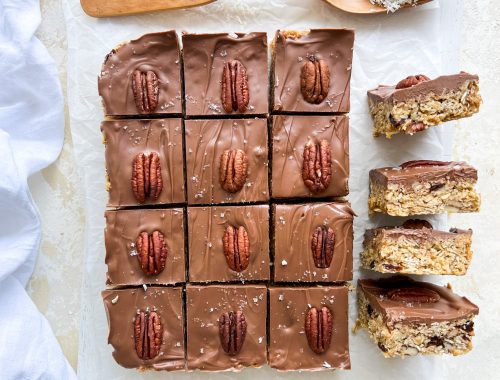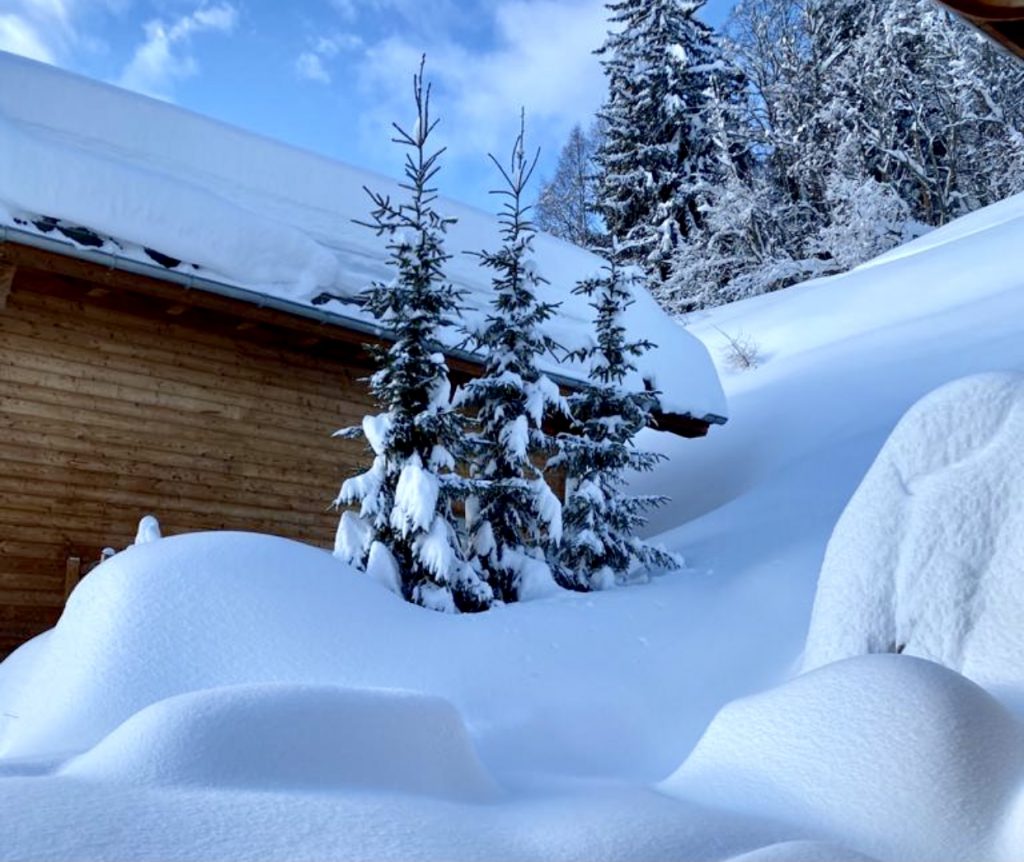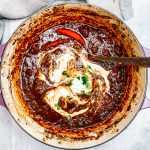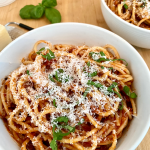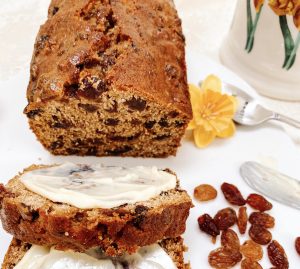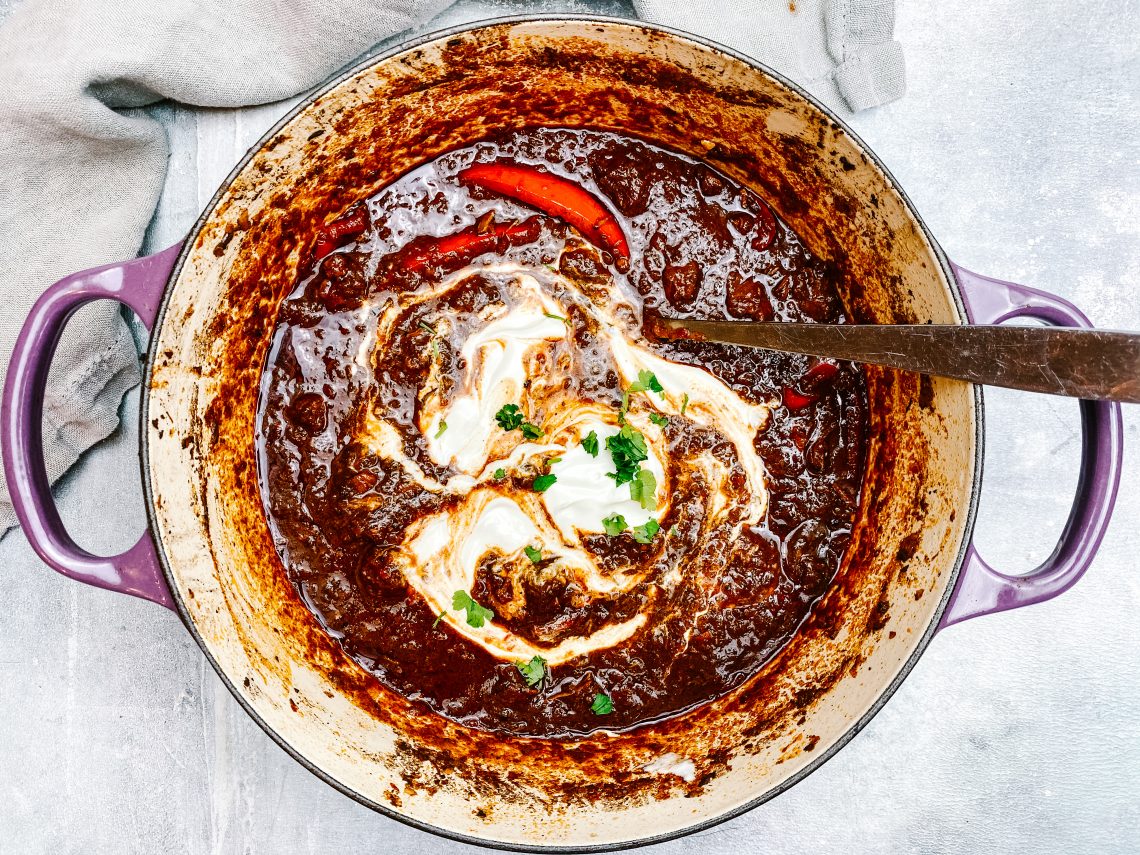
Hungarian Goulash
Chunks of fall apart beef cooked slowly in a rich sauce made from onions, peppers, tomatoes, beef stock, some red wine, layers of paprika – sweet, hot and smoked – the kick of aniseed from caraway seeds, and hints of garlic. Serve with spätzle, pasta or potatoes and top with sour cream and you will have a luscious, creamy, dreamy meal exploding with flavour and goodness.
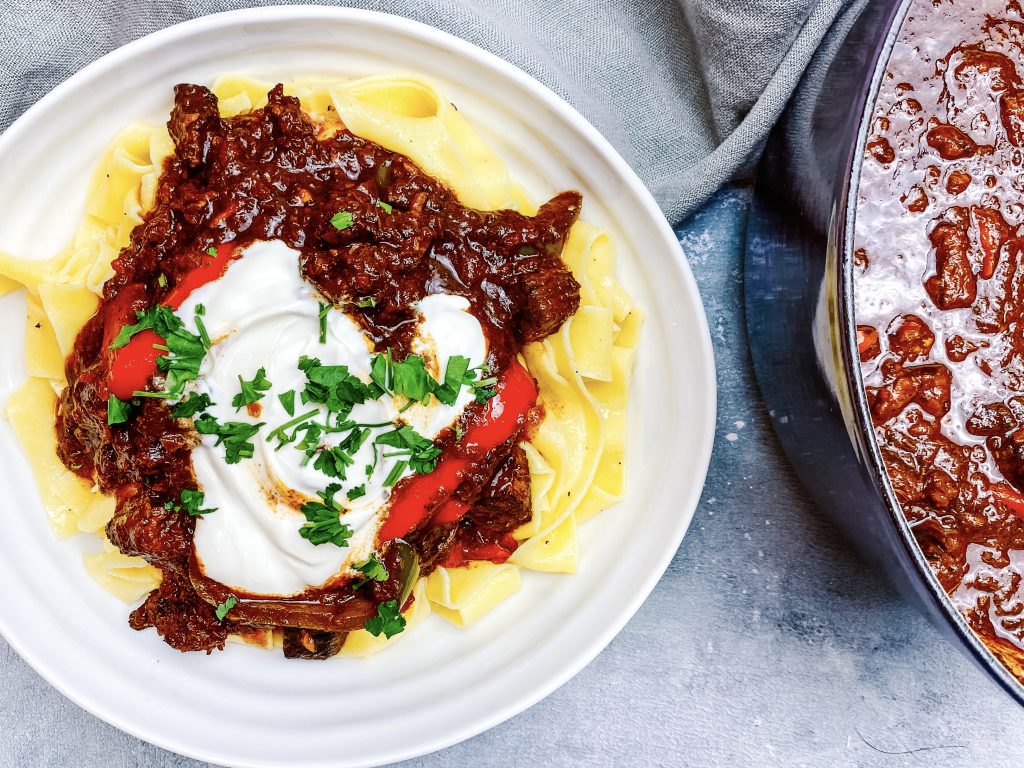
As the name suggests, this wonderful dish hails from Hungary but is hugely popular all over central Europe. I fell in love with it when I lived in Austria in the early 1990s. It features strongly throughout the country largely because of its links with Hungary and the old Austro-Hungarian Empire, which was a great power in Europe between 1867 and 1918.
References to goulash can be found going back to the 9th century. At this stage it would have been a dish made from meat (or parts of an animal – they literally used everything!) cooked with onions and herbs and then dried in the sun. The Magyar shepherds would carry the meat in sacks, made from sheep’s stomach, and then re-constitute with water when they needed to eat!
You will see many different spellings: Goulash, Goulasch, Gulasch. In Hungary it is called Gulyás which originates from the Hungarian word for herdsman. The most popular spelling seems to be goulash so I shall stick to that!
Fortunately, this recipe is not a 9th century version. Today, goulash is flavoured with paprika and caraway seeds and cooked with tomatoes and peppers/capsicum. These additions were not introduced until much later with changes recorded from the 18th century onwards.
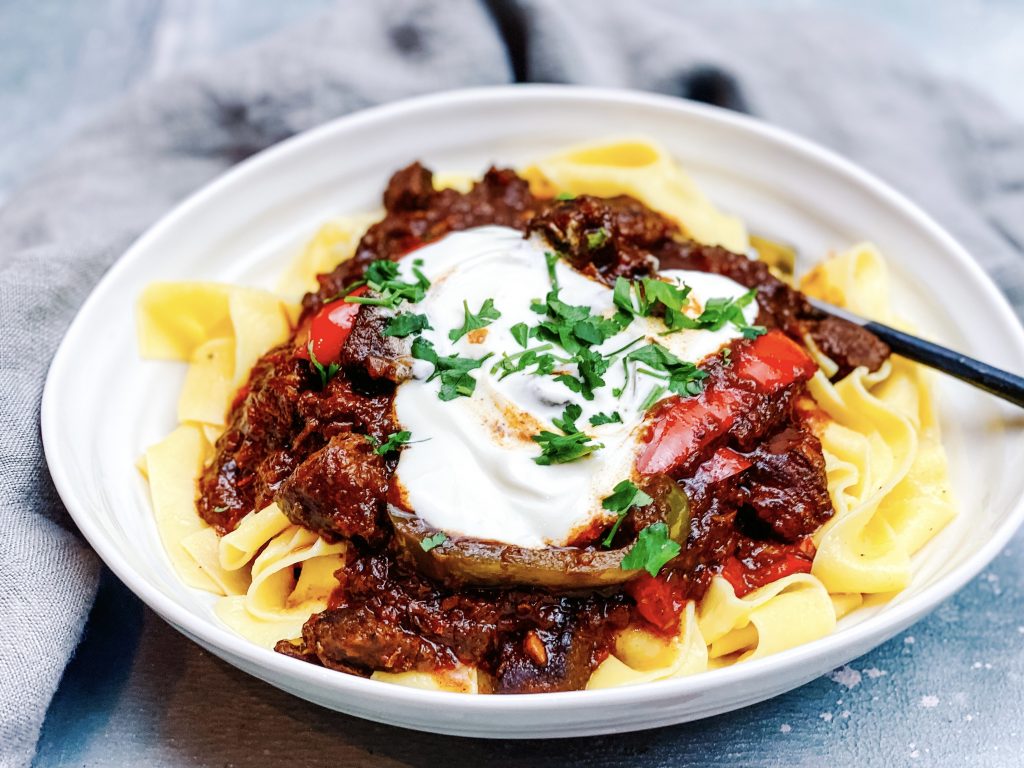
Goulash Spice
The key to ensuring the authenticity and complexity of flavours is to get hold of a range of different Hungarian paprikas. Unless you are very lucky you will not find them in your supermarket but they are all easily available on line and in spice shops. (However, see Recipe Notes, below for options.) Ideally you will need:
- Sweet Hungarian paprika powder
- Hot Hungarian paprika powder
- Medium Hungarian paprika powder
- Smoked Hungarian paprika powder
- Caraway seeds
- Dried marjoram
- Garlic powder
- Onion powder
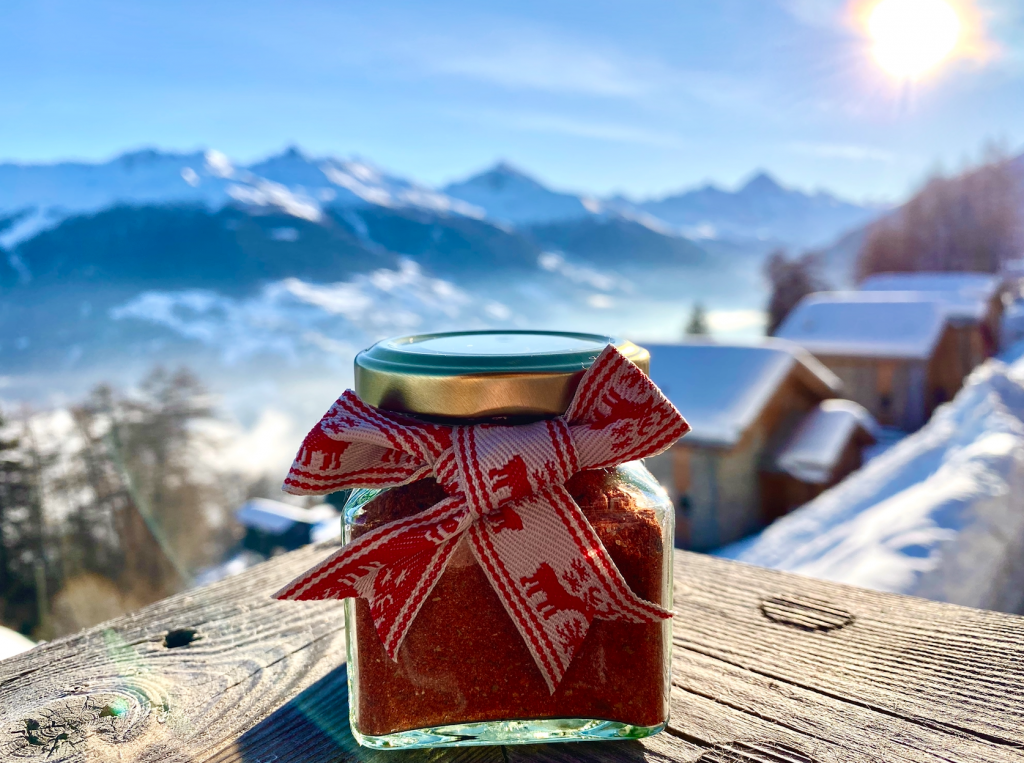
Soup and Stew
Whenever I think of Goulash, I think of the mountains. More often than not, for me, this will be the Swiss Alps. Virtually every restaurant on the slopes over here (and indeed ski slopes across Europe) features a Goulash soup or stew. Whenever I eat Goulash, wherever I am, I am immediately transported to central Europe, either Graz in Austria and of course, Switzerland.
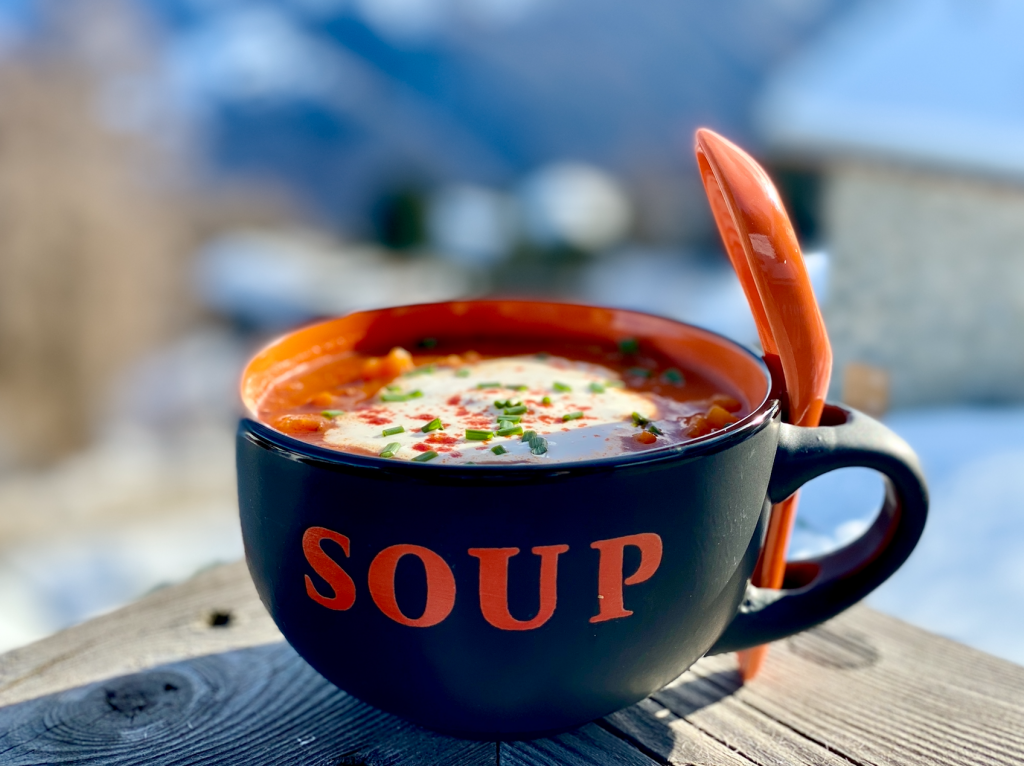
Switzerland
We normally spend 2 – 3 months of each year in Switzerland. We have so many memories of magical Christmases, with family and friends from afar, being snowed in, losing turkeys in snow drifts and getting the car stuck in the snow (that’s just me actually!) Andrew and the girls are all fabulous skiers. Andrew spends most weekends ski touring in the winter (unless Wales have a home match in Cardiff!), Charlotte loves to ski race competitively and Emma has taken to snow boarding as well as skiing. I, on the other hand, have been born without the need to feel the speed and make slow and stately descents of relatively easy pistes as well as the occasional trip out on cross country skis and snow shoes. I compensate by fully committing to après ski!
Christmas notwithstanding, I think my favourite time of year here is summer. The scenery, clean air and the serenity of being in the mountains is the perfect antidote to London. It is a place to relax, take stock and re-charge our batteries. Sadly, in the past 12 months, we have only been able to spend 1 week there, so I am posting this recipe today, hoping the world will open up soon and we can all go back.
How to make Hungarian Goulash
Collect all your ingredients together:
Hungarian Goulash spice mix: (See Recipe Notes for standard supermarket alternatives.)
- Hungarian paprika powder, sweet
- Hungarian paprika powder, hot
- Hungarian paprika powder, medium
- Hungarian paprika powder, smoked
- caraway seeds
- dried marjoram
- garlic powder
- onion powder
Vegetables and Meat mix:
- Hungarian Goulash spice mix
- plain/all-purpose flour
- braising steak, chopped
- olive oil
- unsalted butter
- onions, peeled and roughly chopped
- cloves of garlic, peeled
- carrots, trimmed and roughly chopped
- red pepper, stems removed, deseeded and roughly chopped
- green pepper, stems removed, deseeded and roughly chopped
Goulash Sauce:
- red wine
- beef stock
- tomato puree
- soft brown sugar
- bay leaves
- fine salt
- freshly ground black pepper
- red pepper, stems removed, deseeded and chopped into strips
- green pepper, stems removed, deseeded and chopped into strips
To serve:
- sour cream
- sprinkling of sweet paprika
- chopped parsley
- spätzle, pasta – I like pappardelle, mashed potatoes, buttered potatoes or rice
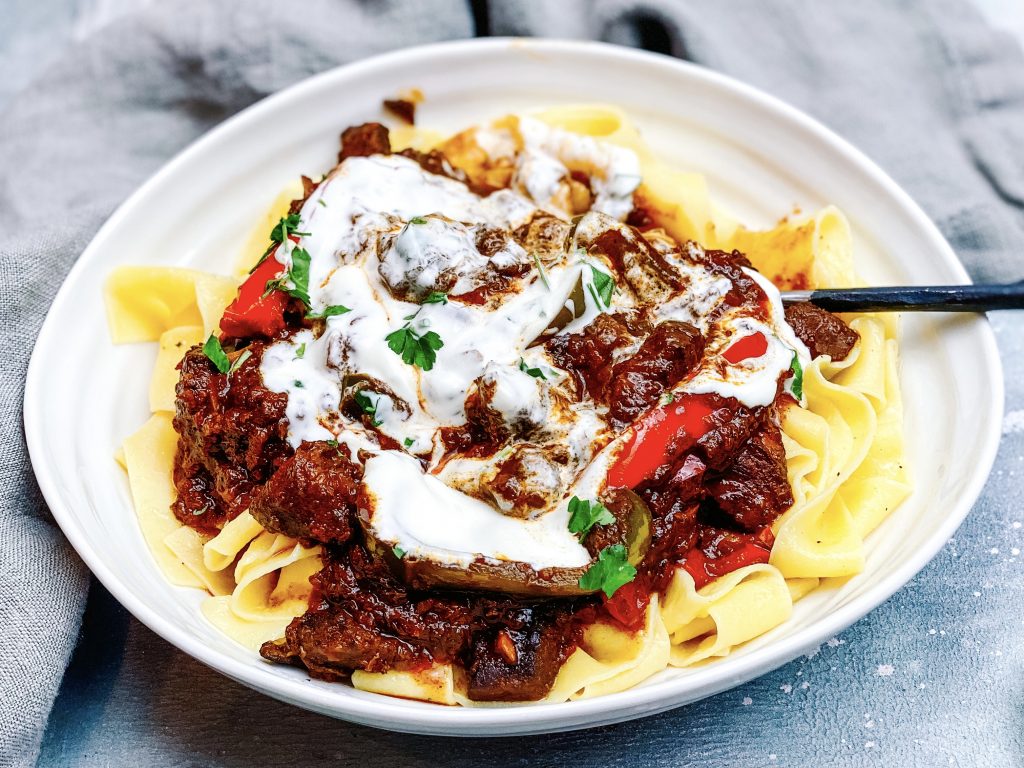
How to make this fabulous Goulash:
- Hungarian Goulash spice mix: mix all the ingredients together and combine with the flour in a large mixing bowl.
- Vegetables and meat mix: Add the meat to the flour and spice mix and stir well, ensuring each piece of meat is coated in the flour and spice.
- Add half the olive oil to a large cast iron casserole and start browning the meat – you will need to do this in stages. As you brown the meat, remove from the pan before adding more beef to brown. If you try to do it all at once you will end up steaming, rather than frying, the beef and you won’t be able to get that gorgeous brown crust you are looking for. Add more oil as required. I find that it can stick quite badly to my Le Creuset cast iron pan. A little but of sticking is good and will add flavour, too much and it will burn. If it is beginning to stick too much, fry the beef in a non stick pan.
- As the beef cooks, prepare the vegetables as specified in the ingredients list. Place them in a food processor and blitz until finely chopped. Alternatively, finely chop by hand.
- Add the chopped vegetables to the pan with the butter.
- Cook over a moderate heat for 10 – 15 minutes until softened and slightly caramelised. Scrape up all the sticky bits from the base of the pan as you cook it.
- When the vegetables are cooked, add the meat back to the pan with the vegetables.
- Goulash Sauce: add the red wine to the pan to deglaze. Bring to the boil and reduce by half, whilst scraping any remaining bits from the base of the pan.
- Add the stock, tomato puree, bay leaves, sugar, salt and pepper.
- Stir well, bring to the boil, put the lid on and put in the oven for 2 hours.
- Prepare the remaining peppers/capsicum – remove the stems, deseed and slice into strips
- After 2 hours, remove the Goulash from the oven, stir well, taste and adjust seasoning if necessary. Add the sliced red and green peppers.
- Continue to cook for a further 45 minutes.
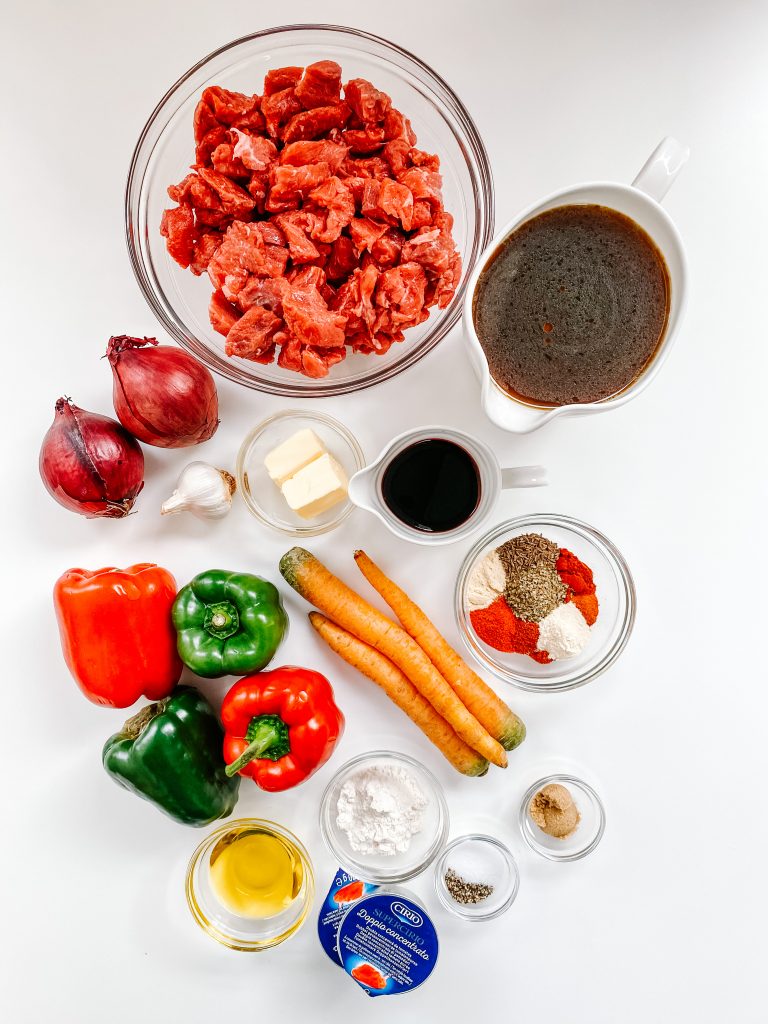
Ingredients 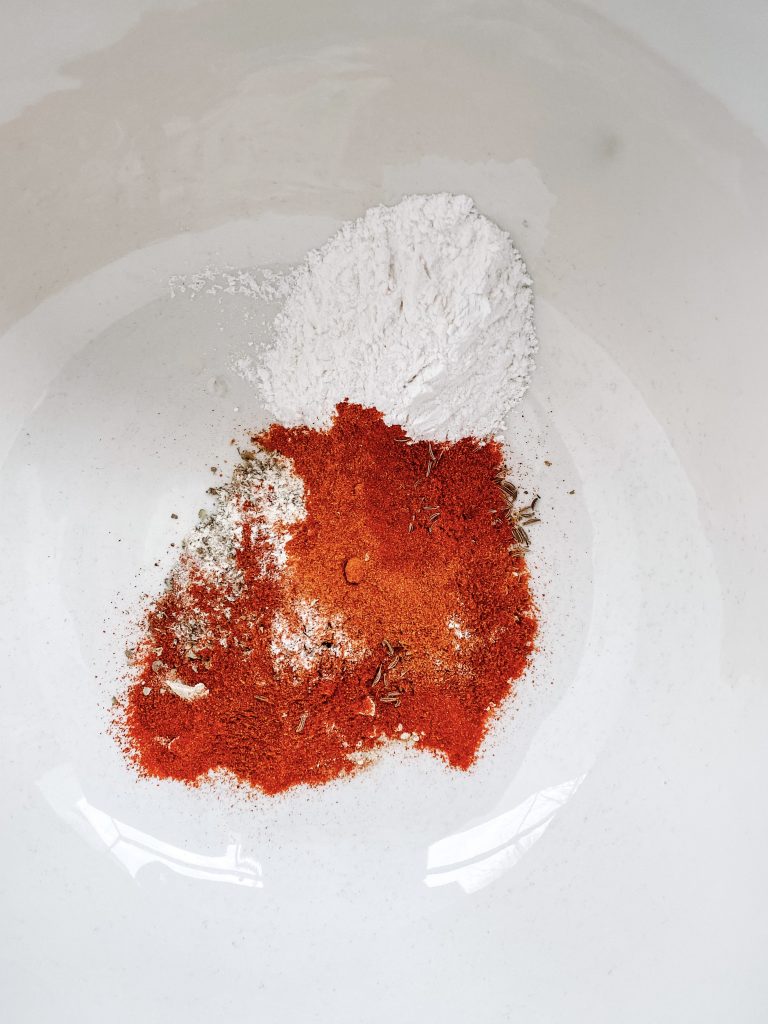
1 Mix all spice ingredients together … 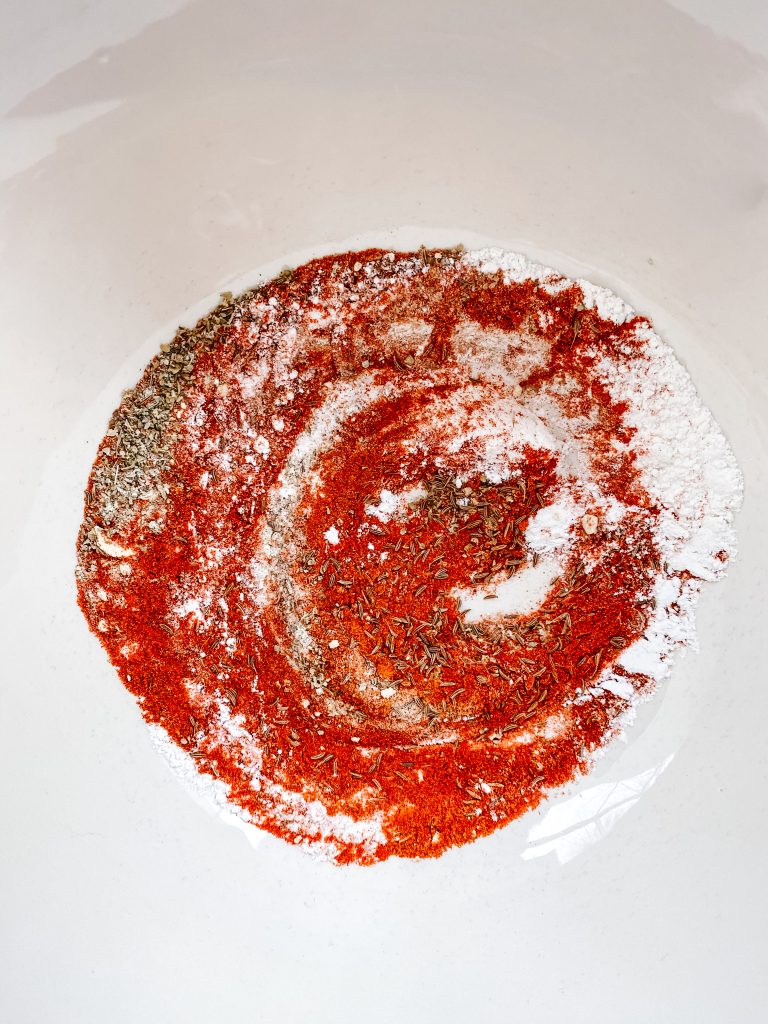
… and combine with flour 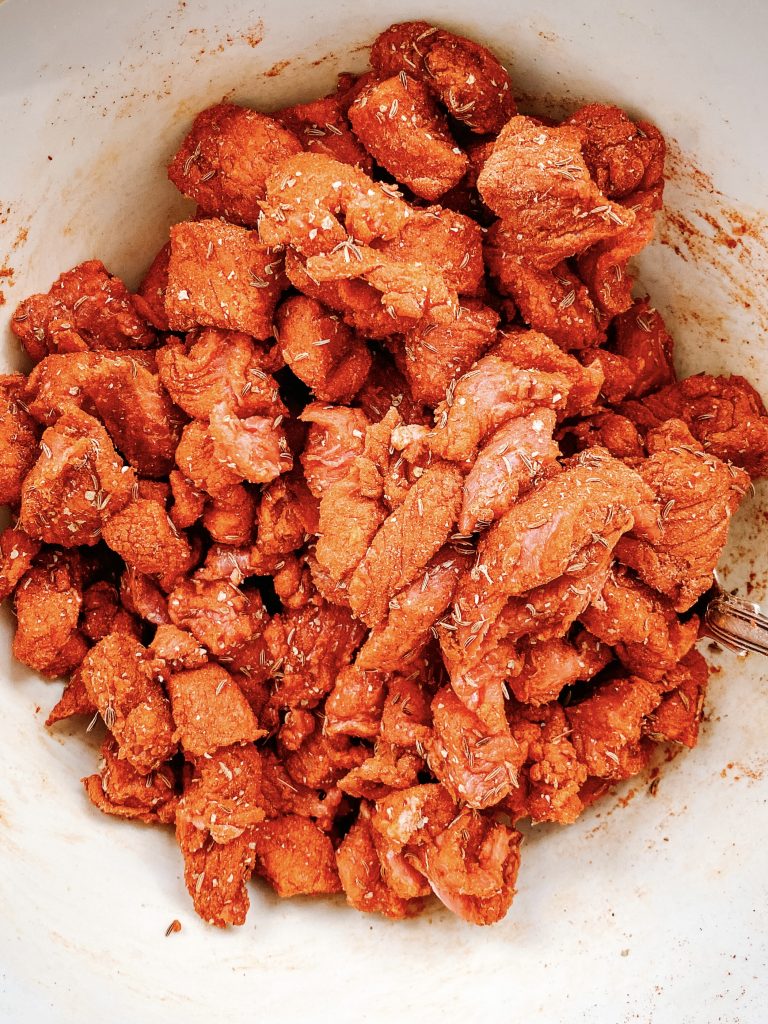
2 Add meat to flour/spice mix and stir well 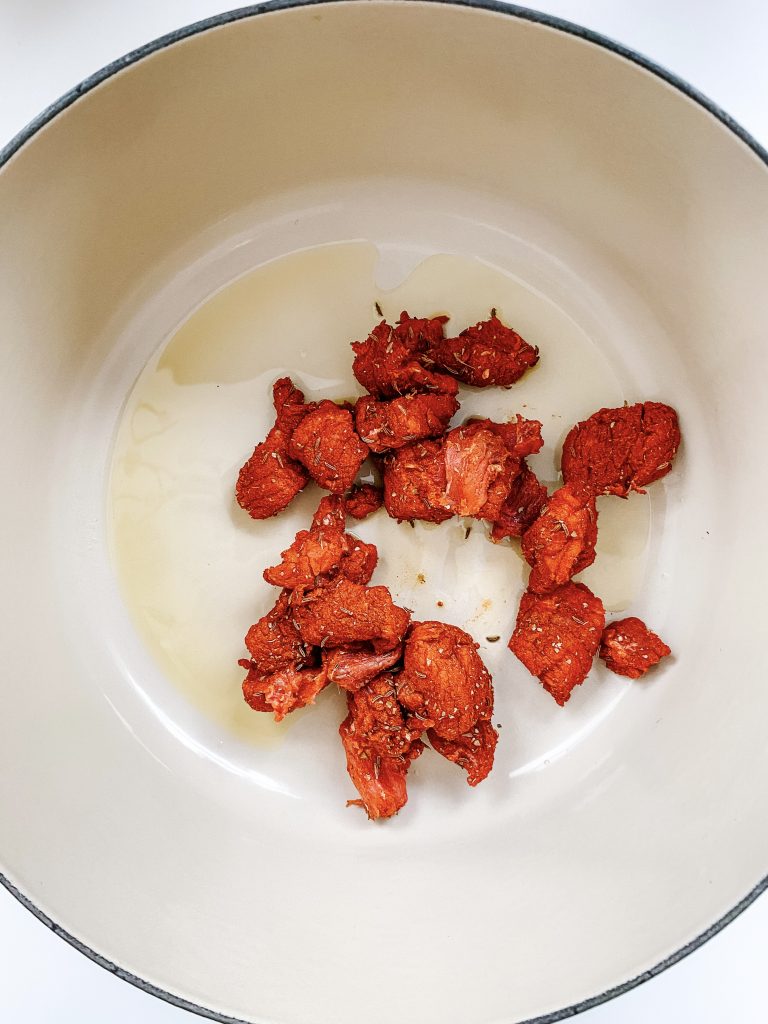
3 Heat oil and brown meat in stages 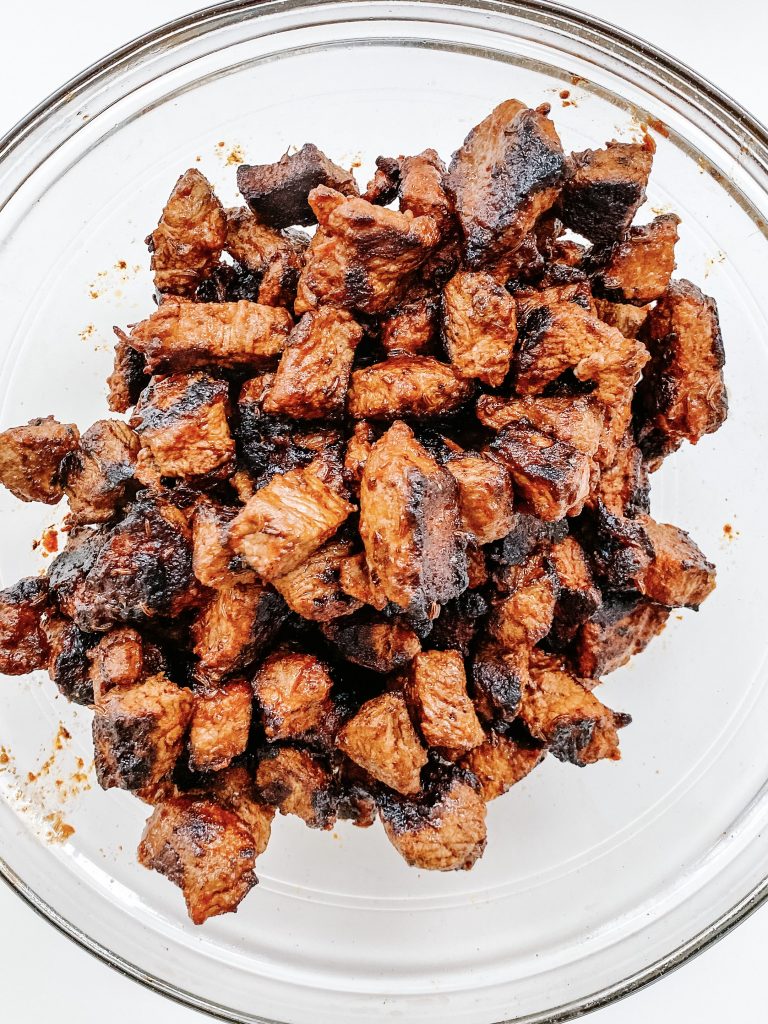
Remove from the pan 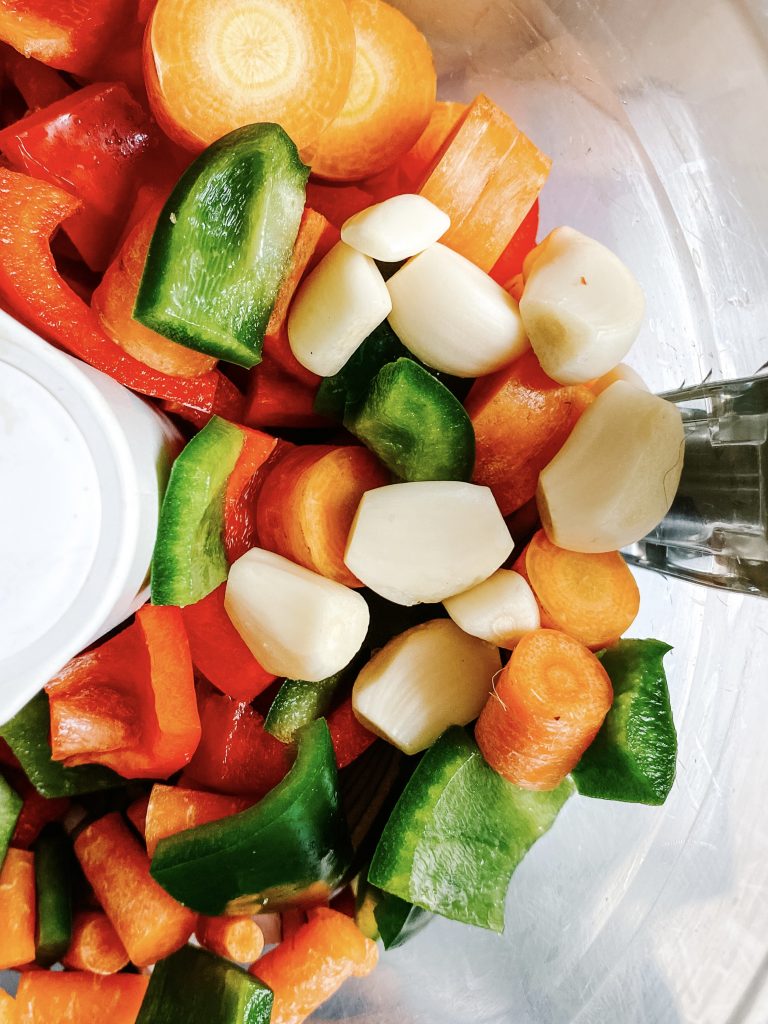
4 Prepare vegetables … 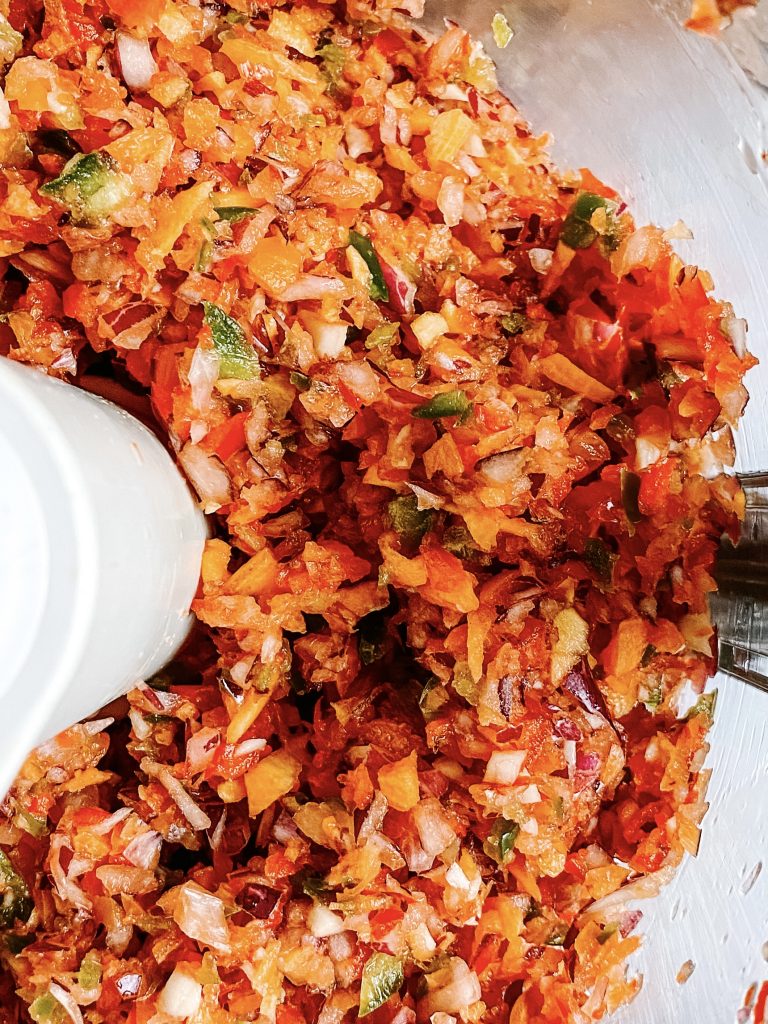
blitz to finely chop 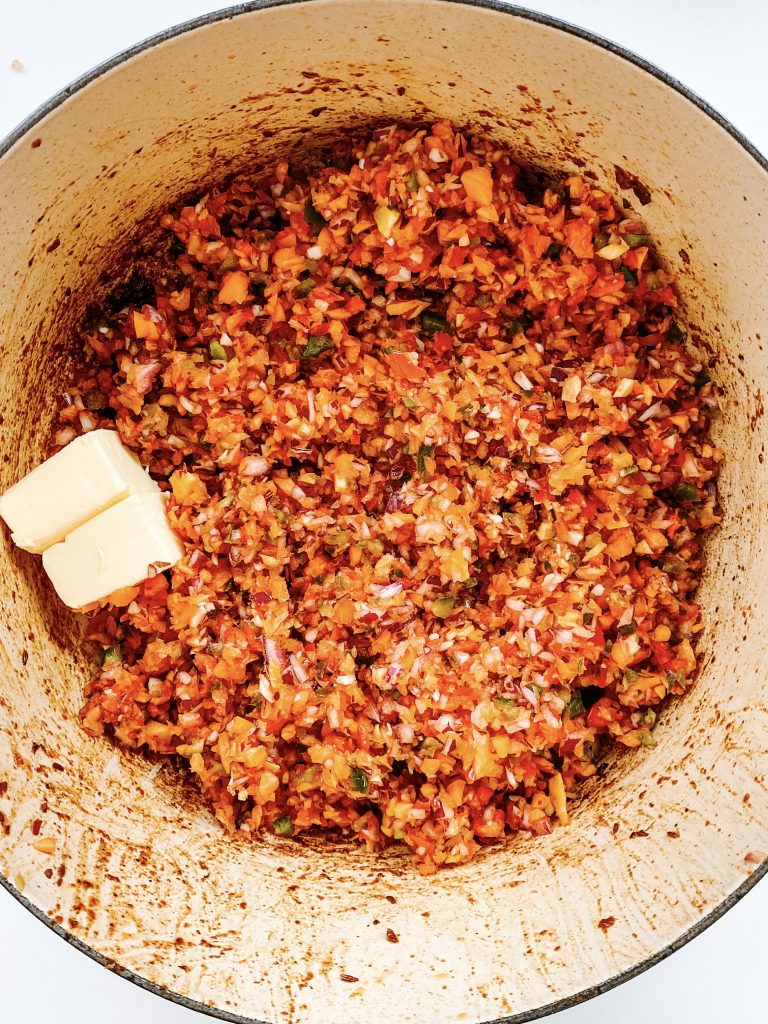
5 Add to pan with butter 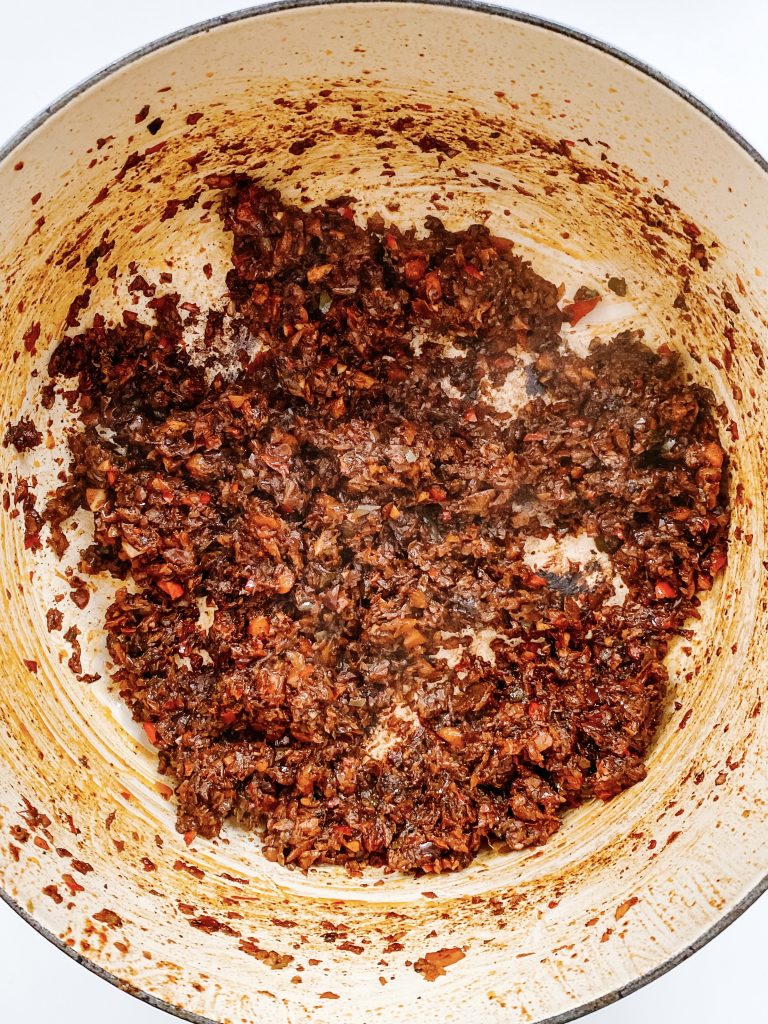
6 Cook for 10 – 15 mins.. 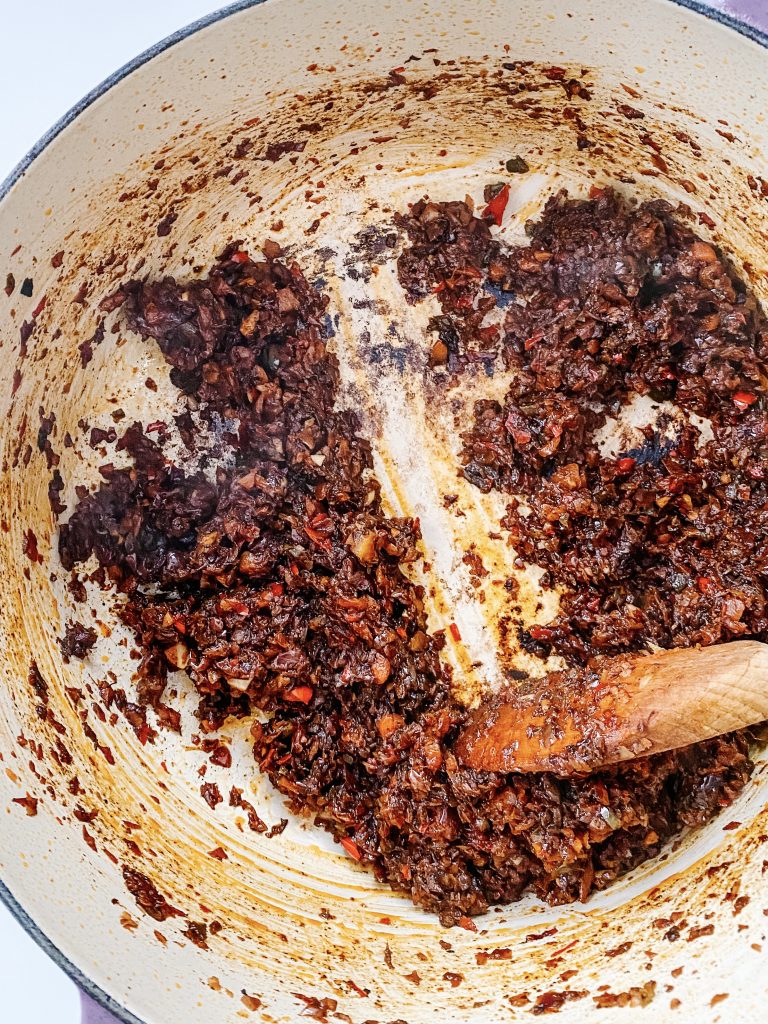
..scarping up any sticky bits 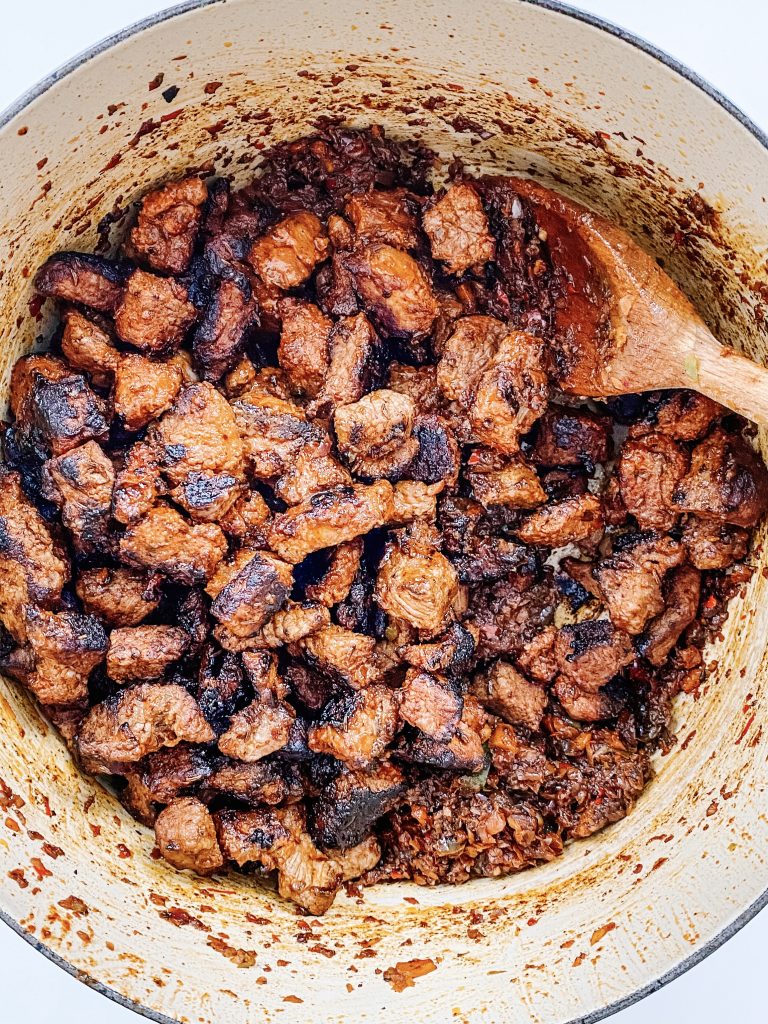
7 Return beef to pan 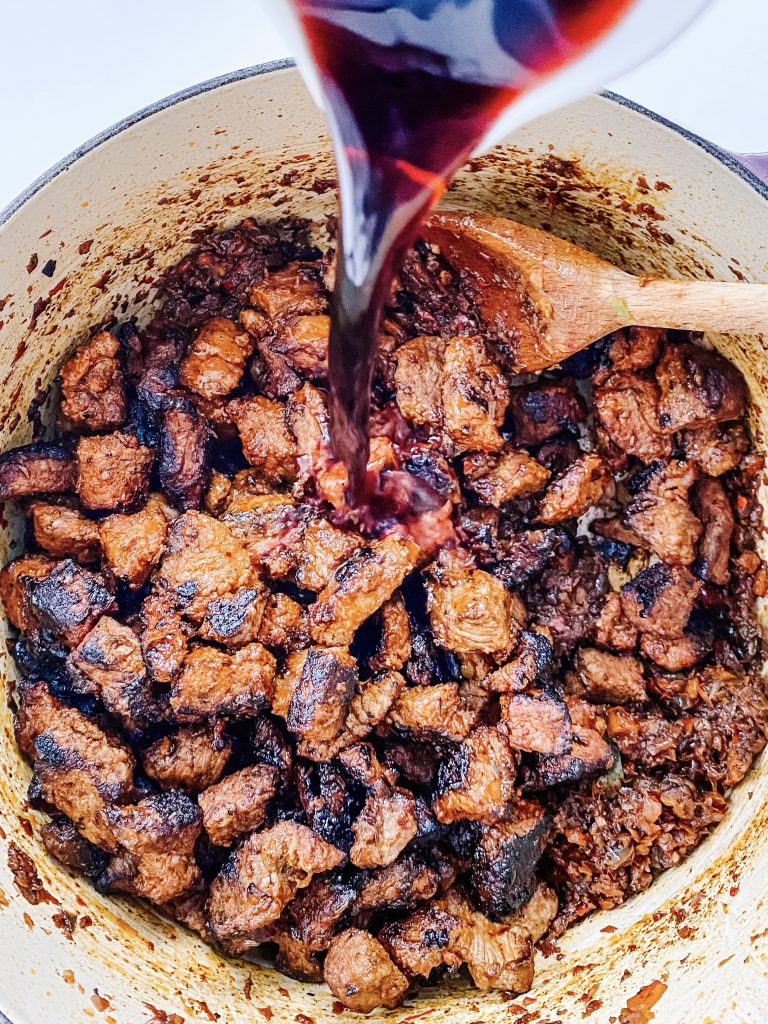
8 Deglaze with red wine and reduce by half 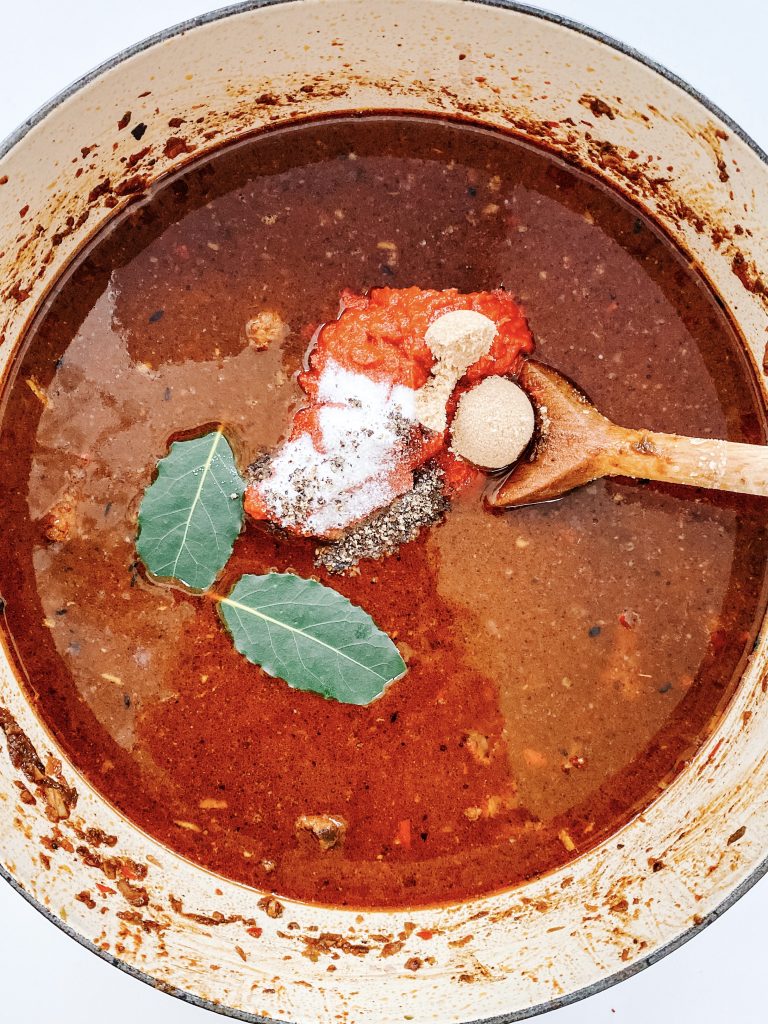
9 Add stock, tomato puree, seasoning & herbs 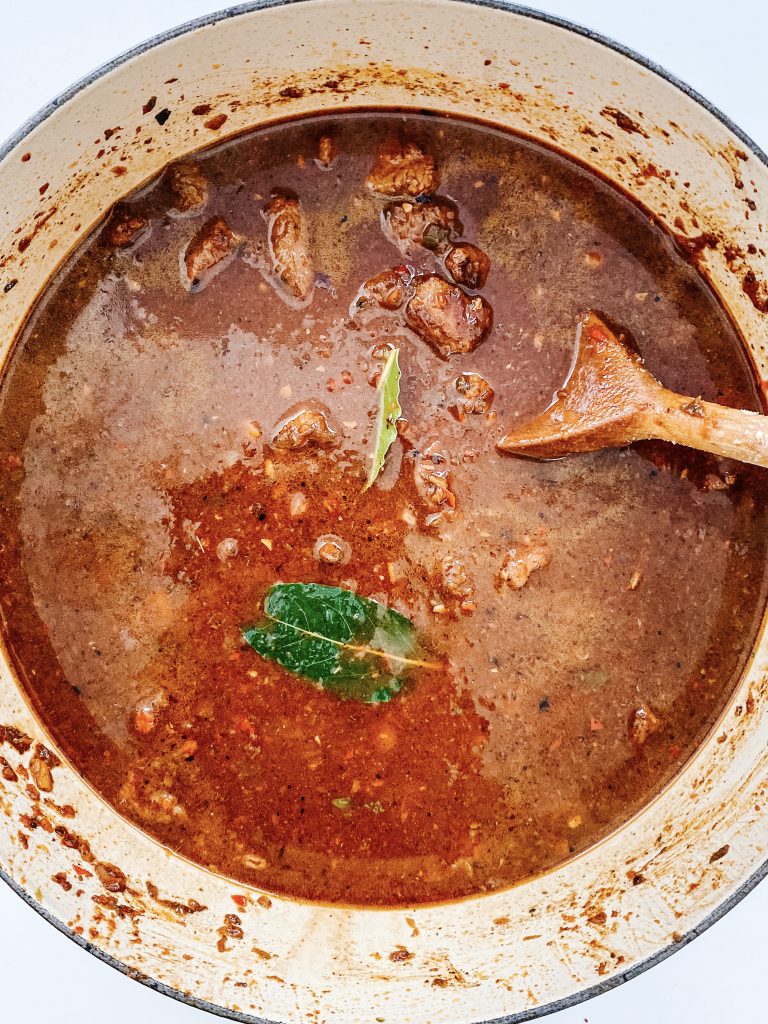
Stir well 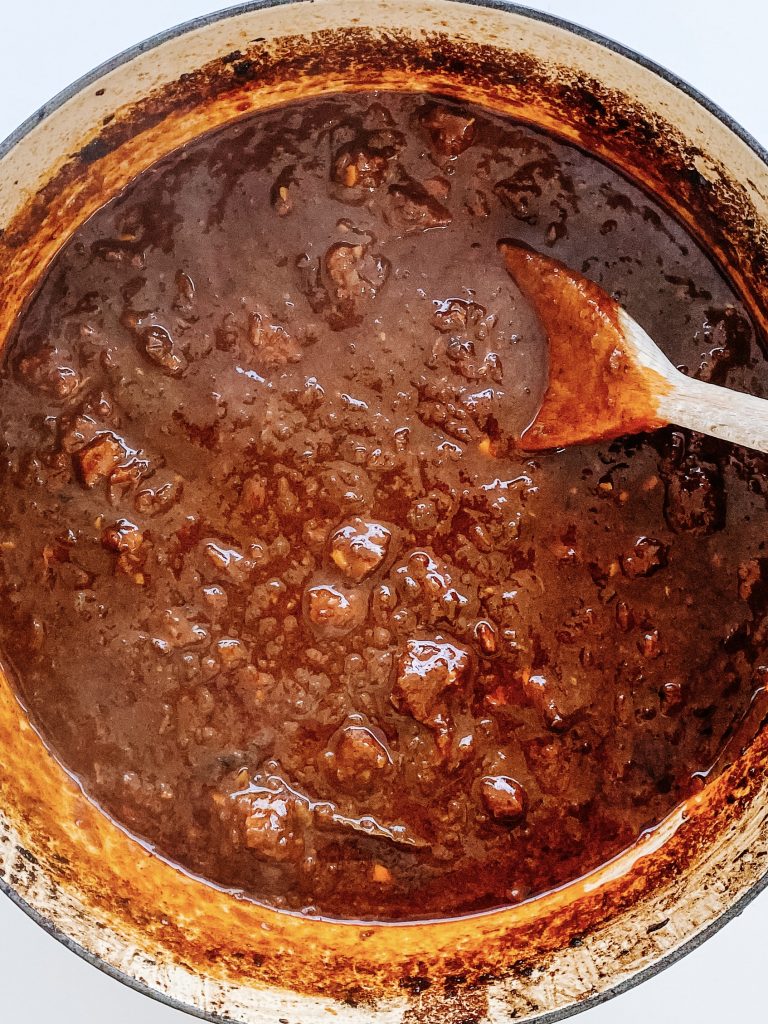
10 Cook, lid on, for 2 hours 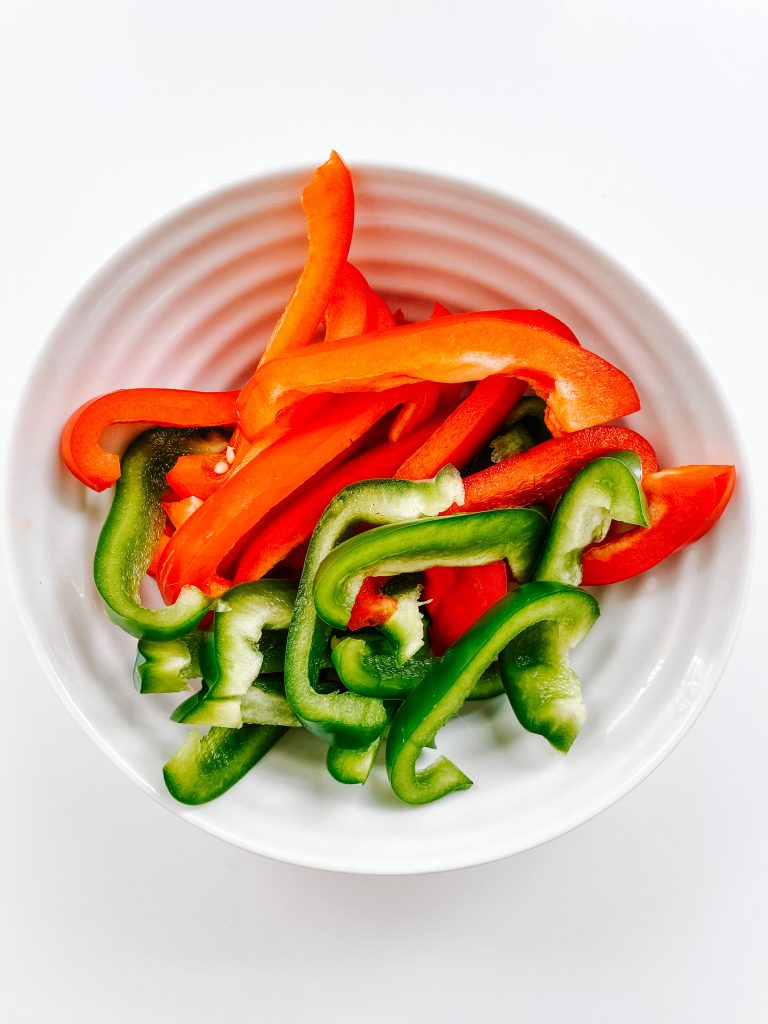
11 Prepare remaining peppers 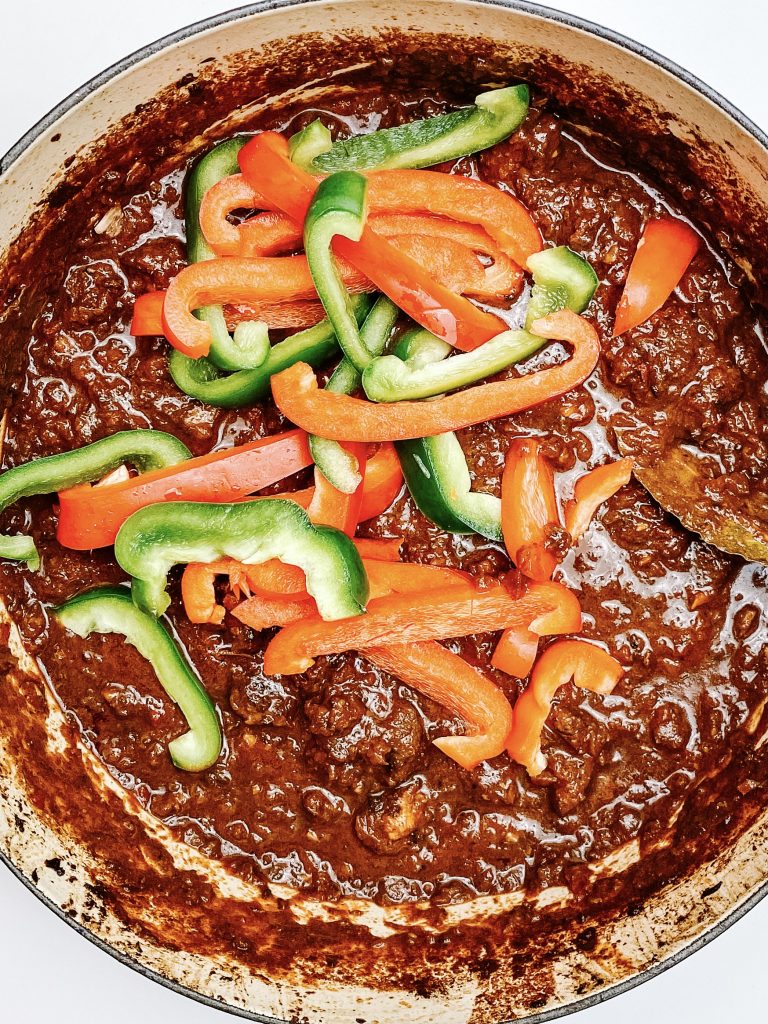
12 After 2 hours, add peppers 
13 Cook for a further 45 mins
Serve:
Serve the Goulash garnished with sour cream, some paprika and chopped parsley and with your choice from spätzle, pasta such as pappardelle, mashed potatoes, buttered potatoes or rice.
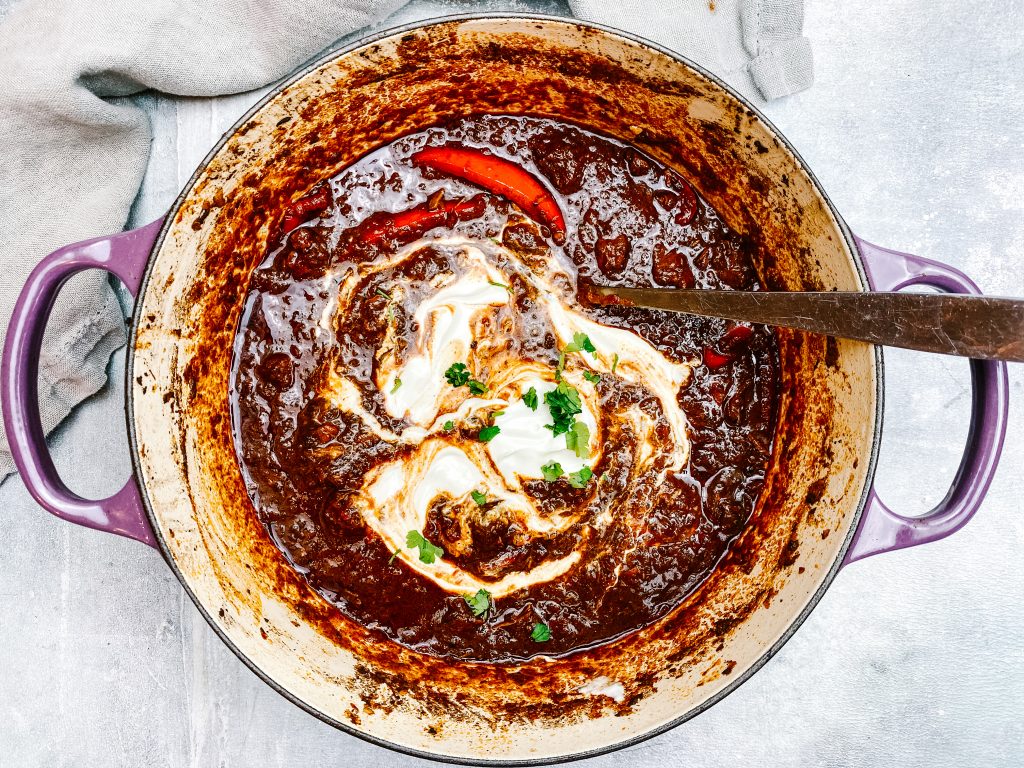
Made this recipe?
If you make this recipe, do please tag me on instagram @daffodil_kitchen. You could also leave a comment in the box directly below the recipe.
Hungarian Goulash
Chunks of fall apart beef cooked slowly in a rich sauce made from onions, peppers, tomatoes, beef stock, some red wine, layers of paprika – sweet, hot and smoked – and the kick of aniseed from caraway seeds. Serves 4 – 6
Ingredients
Hungarian Goulash spice mix: (See Recipe Notes for alternatives.)
- 2½ teaspoons Hungarian paprika powder, sweet
- 2 teaspoons Hungarian paprika powder, hot
- 1 teaspoon Hungarian paprika powder, medium
- 1 teaspoon Hungarian paprika powder, smoked
- 2 teaspoons caraway seeds
- 1½ teaspoons dried marjoram
- 1 teaspoon garlic powder
- ½ teaspoon onion powder
Vegetables and Meat mix:
- Hungarian Goulash spice mix
- 2 tablespoons plain/all-purpose flour
- 1kg braising steak, chopped
- 2 – 3 tablespoons olive oil
- 50g unsalted butter
- 250 – 300g/2 onions, peeled and roughly chopped
- 32g/8 cloves of garlic, peeled
- 200g/2 carrots, trimmed and roughly chopped
- 1 red pepper, stems removed, deseeded and roughly chopped
- 1 green pepper, stems removed, deseeded and roughly chopped
Goulash Sauce:
- 125ml/½ cup red wine
- 1 litre of beef stock
- 140g tomato puree
- 1½ teaspoons soft brown sugar
- 2 bay leaves
- 1 teaspoon fine salt
- ½ teaspoon freshly ground black pepper
- 1 red pepper, stems removed, deseeded and chopped into strips
- 1 green pepper, stems removed, deseeded and chopped into strips
To serve:
- 60 – 90ml sour cream
- sprinkling of sweet paprika
- chopped parsley
- spätzle, pasta – I like papardelle, mashed potatoes, buttered potatoes or rice
Instructions
-
Hungarian Goulash spice mix: mix all the ingredients together and combine with the flour in a large mixing bowl.
-
Vegetables and meat mix: Add the meat to the flour and spice mix and stir well, ensuring each piece of meat is coated in the flour and spice.
-
Add half the olive oil to a large cast iron casserole and start browning the meat – you will need to do this in stages. As you brown the meat, remove from the pan before adding more beef to brown. (See Recipe Notes).
-
As the beef cooks, prepare the vegetables as specified in the ingredients list. Place them in a food processor and blitz until finely chopped. Alternatively, finely chop by hand.
-
Add the chopped vegetables to the pan with the butter.
-
Cook over a moderate heat for 10 – 15 minutes until softened and slightly caramelised. Scrape up all the sticky bits from the base of the pan as you cook it.
-
When the vegetables are cooked, add the meat back to the pan with the vegetables.
-
Preheat oven to Fan Oven 130°C/150°C/300°F/Gas2.
-
Goulash Sauce: add the red wine to the pan to deglaze. Bring to the boil and reduce by half, whilst scraping any remaining bits from the base of the pan.
-
Add the stock, tomato puree, bay leaves, sugar, salt and pepper.
-
Stir well, bring to the boil, put the lid on and put in the oven for 2 hours.
-
Prepare the remaining peppers/capsicum – remove the stems, deseed and slice into strips.
-
After 2 hours, remove the Goulash from the oven, stir well, taste and adjust seasoning if necessary.
-
Add the sliced red and green peppers and continue to cook for a further 45 minutes.
-
Serve: serve the Goulash garnished with sour cream, some paprika and chopped parsley and with your choice from spätzle, pasta such as pappardelle, mashed potatoes, buttered potatoes or rice.
Recipe Notes
Equipment:
- chopping board and knife
- kitchen scales and measuring spoons
- mixing bowl
- cast iron casserole/Dutch oven
- plate/bowl
- nonstick frying pan, if necessary
Paprika
If you are unable to get Hungarian Paprika, replace with:
- 1½ tablespoons normal paprika – the one you buy from the supermarket
- ½ teaspoon smoked paprika
- caraway seeds, marjoram, garlic and onion, as above
Taste the Goulash after it has been cooking for 2 hours. Add additional paprika and smoked paprika with the peppers, if necessary and according to taste.
Browning the beef:
If you try to do it all at once you will end up steaming, rather than frying, the beef and you won’t be able to get that gorgeous brown crust you are looking for. Add more oil as required.
Is the beef sticking to your pan?
I find that the beef can stick quite badly to my Le Creuset cast iron pan. A little but of sticking is good and will add flavour, too much and it will burn. If it is beginning to stick too much, fry the beef in a non stick pan.
You May Also Like
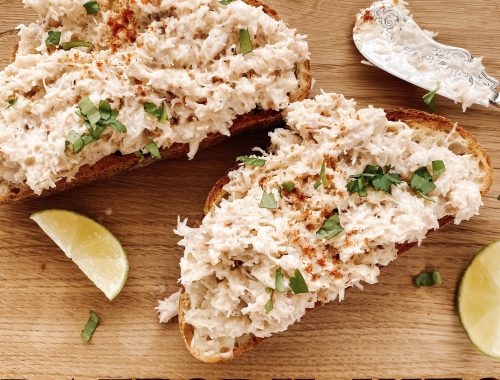
White Crab on Sour Dough Toast
15th May 2020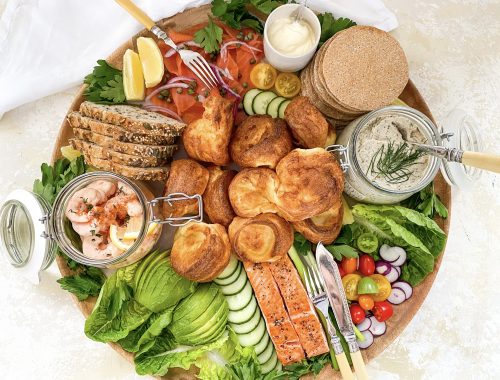
Fish Grazing Platter with Yorkshire Puddings
29th December 2021